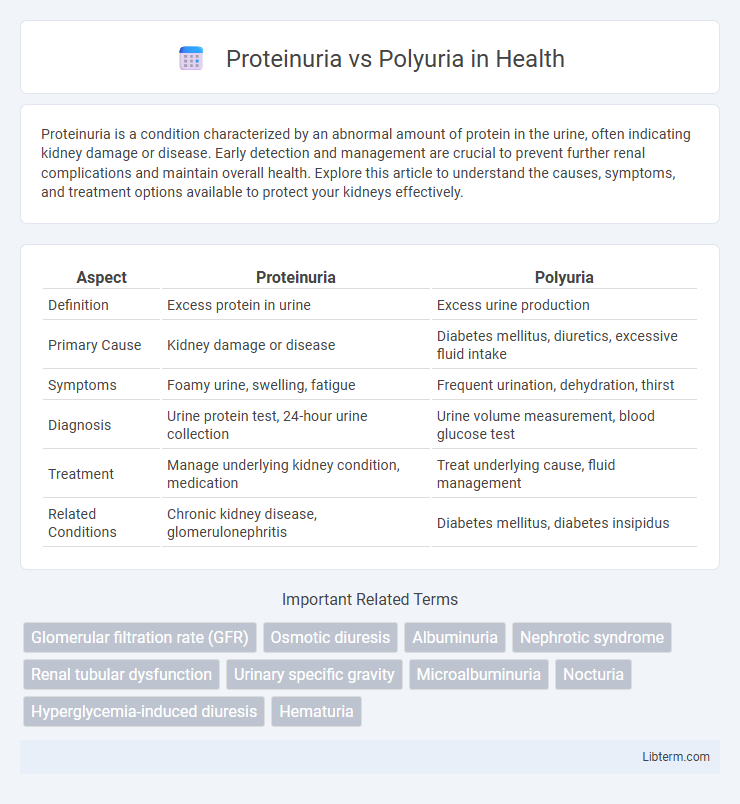Proteinuria is a condition characterized by an abnormal amount of protein in the urine, often indicating kidney damage or disease. Early detection and management are crucial to prevent further renal complications and maintain overall health. Explore this article to understand the causes, symptoms, and treatment options available to protect your kidneys effectively.
Table of Comparison
| Aspect | Proteinuria | Polyuria |
|---|---|---|
| Definition | Excess protein in urine | Excess urine production |
| Primary Cause | Kidney damage or disease | Diabetes mellitus, diuretics, excessive fluid intake |
| Symptoms | Foamy urine, swelling, fatigue | Frequent urination, dehydration, thirst |
| Diagnosis | Urine protein test, 24-hour urine collection | Urine volume measurement, blood glucose test |
| Treatment | Manage underlying kidney condition, medication | Treat underlying cause, fluid management |
| Related Conditions | Chronic kidney disease, glomerulonephritis | Diabetes mellitus, diabetes insipidus |
Understanding Proteinuria and Polyuria
Proteinuria is characterized by the abnormal presence of proteins in the urine, often indicating kidney damage or disease, while polyuria refers to the excessive production and passage of urine, typically associated with conditions like diabetes mellitus or diabetes insipidus. Understanding proteinuria involves recognizing its role as a biomarker for glomerular injury or tubular dysfunction, whereas polyuria demands assessment of fluid balance and underlying metabolic or hormonal imbalances. Quantitative urine tests such as 24-hour urine protein measurement and urine volume analysis are essential to differentiate between these conditions and guide appropriate clinical management.
Definition of Proteinuria
Proteinuria refers to the abnormal presence of excess protein in the urine, typically indicating kidney damage or disease affecting the glomeruli. It is a key marker for diagnosing conditions such as glomerulonephritis, diabetic nephropathy, and hypertension-related renal impairment. Polyuria, by contrast, involves the production of abnormally large volumes of dilute urine, often associated with diabetes mellitus or diabetes insipidus.
Definition of Polyuria
Polyuria is defined as the excessive production and passage of urine, typically exceeding 3 liters per day in adults, often caused by conditions such as diabetes mellitus, diabetes insipidus, or excessive fluid intake. It differs from proteinuria, which refers to the abnormal presence of protein in the urine indicating kidney damage or disease. Understanding polyuria's mechanisms helps differentiate it from proteinuria in clinical diagnosis and treatment.
Causes of Proteinuria
Proteinuria is the presence of excess protein in the urine, commonly caused by kidney-related conditions such as glomerulonephritis, diabetic nephropathy, and hypertension-induced kidney damage. Infections, autoimmune diseases like lupus, and certain medications can also disrupt the glomerular filtration barrier, leading to protein leakage. Unlike polyuria, which involves increased urine output often due to diabetes or diuretics, proteinuria specifically signals underlying renal pathology affecting protein retention.
Causes of Polyuria
Polyuria is characterized by excessive urine production and can be caused by conditions such as diabetes mellitus, where high blood glucose levels lead to osmotic diuresis. Other causes include diabetes insipidus due to antidiuretic hormone imbalance, and substances like diuretics or caffeine that increase urine output. Polyuria may also result from chronic kidney disease or excessive fluid intake, making it essential to distinguish from proteinuria, which involves abnormal protein excretion in urine.
Symptoms: Proteinuria vs Polyuria
Proteinuria is characterized by the presence of excess protein in the urine, often identified through foamy urine, swelling in extremities, and fatigue due to underlying kidney issues. Polyuria involves producing abnormally large volumes of dilute urine, frequently causing excessive thirst and nighttime urination, commonly associated with diabetes or hormonal imbalances. Differentiating symptoms such as edema in proteinuria and increased urination frequency in polyuria are crucial for accurate diagnosis and treatment.
Diagnostic Approaches
Proteinuria diagnosis primarily relies on urine analysis through dipstick tests, followed by quantification using 24-hour urine protein collection or spot urine protein-to-creatinine ratio to assess protein excretion. Polyuria evaluation involves measuring urine volume exceeding 3 liters per day, alongside serum electrolyte tests and water deprivation tests to differentiate causes like diabetes mellitus or diabetes insipidus. Imaging studies and renal function tests support differential diagnosis in both conditions by identifying underlying pathologies affecting kidney function or systemic diseases.
Complications and Health Risks
Proteinuria indicates abnormal protein levels in urine, signaling kidney damage and increasing the risk of chronic kidney disease and cardiovascular complications. Polyuria involves excessive urine production, often linked to diabetes mellitus or diuretic use, leading to dehydration, electrolyte imbalances, and potential kidney strain. Both conditions require medical evaluation to prevent progression to renal failure and systemic health issues.
Treatment Options
Treatment options for proteinuria primarily involve managing the underlying causes such as hypertension and diabetes through ACE inhibitors or ARBs to reduce protein leakage in the urine. Polyuria treatment targets the root condition, often using medications like desmopressin for diabetes insipidus or optimizing glucose control in diabetic patients to reduce excessive urine output. Both conditions benefit from regular monitoring and lifestyle adjustments, including fluid management and dietary modifications to support kidney function and overall health.
Prevention and Lifestyle Tips
Managing proteinuria involves controlling underlying conditions such as hypertension and diabetes through a balanced diet low in salt and protein, regular exercise, and maintaining healthy blood pressure levels. Preventing polyuria focuses on regulating fluid intake, avoiding excessive caffeine and alcohol, and managing blood sugar levels effectively to reduce urine output. Both conditions benefit from routine medical check-ups to monitor kidney function and customize lifestyle adjustments for optimal renal health.
Proteinuria Infographic

 libterm.com
libterm.com